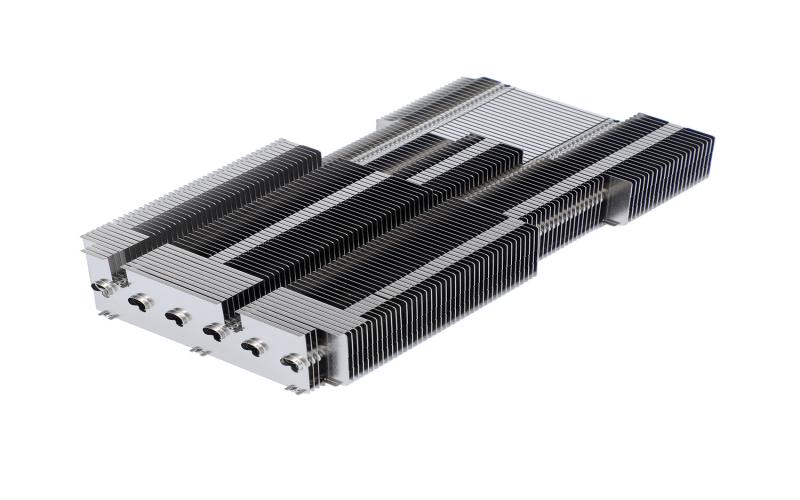Introduction
Stamped fin heatsinks in copper and aluminum are commonly used in electronic devices to dissipate heat and maintain optimal operating temperatures. These heatsinks are designed with a large surface area, allowing for effective heat transfer from the electronic components to the surrounding environment. In this article, we will explore the benefits and applications of stamped fin heatsinks, as well as the differences between copper and aluminum variants.
The Importance of Efficient Heat Dissipation
Heat dissipation is a critical aspect of electronic device design, as excessive heat can lead to reduced performance, component failure, and decreased lifespan. Stamped fin heatsinks play a vital role in dissipating heat generated by electronic components such as CPUs, GPUs, power transistors, and LED lights. By efficiently transferring heat away from these components, stamped fin heatsinks help maintain their optimal operating temperatures, ensuring reliable and long-lasting performance.
Understanding Stamped Fin Heatsinks
Stamped fin heatsinks are manufactured using a stamping process that shapes metal sheets into a finned structure. The fins increase the surface area of the heatsink, allowing for enhanced heat dissipation. The choice of material, whether copper or aluminum, depends on various factors such as thermal conductivity, weight, cost, and application requirements.
Advantages of Copper Stamped Fin Heatsinks
Copper is a popular choice for stamped fin heatsinks due to its excellent thermal conductivity. It efficiently transfers heat from the electronic components to the fins and dissipates it into the surrounding environment. Copper heatsinks also have high mechanical strength and can withstand demanding applications. Additionally, copper is highly resistant to corrosion, ensuring the longevity of the heatsink.
Advantages of Aluminum Stamped Fin Heatsinks
Aluminum stamped fin heatsinks offer several advantages, making them a preferred choice in many applications. Aluminum is lightweight, which is beneficial for portable devices and applications where weight is a consideration. Aluminum heatsinks are also cost-effective compared to copper heatsinks. While aluminum has a lower thermal conductivity than copper, it still provides efficient heat dissipation when designed properly.
Applications of Stamped Fin Heatsinks
Stamped fin heatsinks find applications in a wide range of electronic devices across various industries. They are commonly used in computers, servers, telecommunications equipment, power supplies, automotive electronics, LED lighting, and industrial machinery. The versatility and effectiveness of stamped fin heatsinks make them suitable for both consumer and industrial applications.
Design Considerations for Stamped Fin Heatsinks
When designing a stamped fin heatsink, several factors should be taken into account. The number and dimensions of the fins, the base thickness, and the overall size of the heatsink play a crucial role in its thermal performance. Proper airflow and the use of thermal interface materials are also essential to maximize heat dissipation. Additionally, the choice of material, whether copper or aluminum, should be based on the specific requirements and constraints of the application.
Manufacturing Process of Stamped Fin Heatsinks
The manufacturing process of stamped fin heatsinks involves several steps. First, metal sheets of copper or aluminum are stamped to create the finned structure. The fins are then formed and shaped to achieve the desired design. Next, the base of the heatsink is attached, providing a solid foundation. Finally, the heatsinks undergo various finishing processes, including surface treatment and coating, to enhance their performance and durability.
Comparing Copper and Aluminum Stamped Fin Heatsinks
While copper and aluminum stamped fin heatsinks serve the same purpose of heat dissipation, there are some notable differences between the two. Copper heatsinks offer superior thermal conductivity and mechanical strength, making them suitable for applications that require high-performance cooling. On the other hand, aluminum heatsinks are lighter, more cost-effective, and find extensive use in consumer electronics and applications where weight is a concern.
Conclusion
Stamped fin heatsinks in copper and aluminum are essential components in electronic devices, ensuring efficient heat dissipation and optimal operating temperatures. Copper heatsinks excel in thermal conductivity and mechanical strength, while aluminum heatsinks offer lightweight and cost-effective solutions. Understanding the advantages and applications of stamped fin heatsinks allows designers and engineers to make informed decisions when selecting the most suitable cooling solution for their electronic devices.

